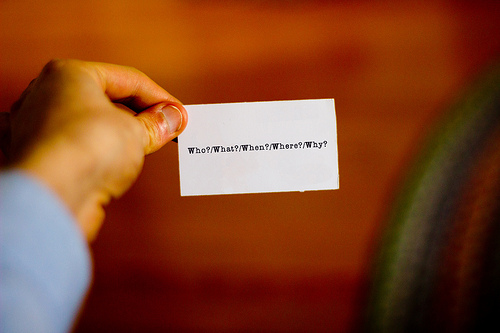
Begin by questioning assumptions & looking at the data
Target audience: Nonprofits, cause organizations, foundations, NGOs, social enterprises, businesses, community managers, Facebook administrators.
Social media used to be all about assumptions: Who is online, what they are doing, how much they love you, whether or not your content resonates. When nonprofits and companies began rapidly adopting social media in the late 2000s, activities were based on assumptions and experimental ideas. Fast forward five years, and we now have at our disposal some solid measurement and data collection software systems, research studies, case studies, demographic data and a relatively savvy social media user base. The problem? We’re still working from hunches and assumptions.
If your organization is not getting what it wants from its social media engagement, question your existing assumptions and look deeply at your own data. Here are a few good questions to ask to take your social media to the next engagement level.
6 questions for social media teams to ask
1Are our social media activities tied to SMART (specific, measurable, attainable, relevant, and time-bound) goals? Surprisingly enough, I hear “no” when I ask that question nine out of 10 times. The doing of social media is usually what consumes staff and organizations. (“We have to be on Facebook!” “We need a Twitter account, right?”) Why? To what end? When we begin by knowing what goals the organization needs to achieve, the direction of social media implementation becomes clear. Here is a relevant case study on how one organization did just that.
2Why are we using these social media channels? Most organizations are using Facebook, Twitter and YouTube, according to a recent NTEN study. But are they the right channels for your organization to optimally engage with your audience? To meet your SMART goals? Do you have the capacity to execute your implementation on these channels properly? It may go against the grain, but not every organization has to have a Facebook page. Really! Maybe a Facebook group is a better choice for you — or not having a Facebook page for a while until you’ve figured out why you want one. Question every channel assumption, and proactively match your channels with your goals, audience and capacity.
3Are we measuring the right things? If you’re not measuring how your organization is engaging online fans, signing them up, and moving them to action, you’re not measuring the right things. Measuring numbers of fans, followers, and even comments isn’t measuring the right stuff. You want to know if your content resonates, if people care and if they’ll go the mile for your cause.
One way to test your current measurement system is to simply eyeball your social media channels with these questions in mind: Do the stakeholders care what we’re doing on these channels – and how are we capturing this in any kind of tracking system? Two key metrics to consider are: How committed is the entire community we’ve built, and are we creating a sustainable base of fans and stakeholders? This slide deck contains some ideas on how to track your community’s commitment to your cause, and how likely they are to take action on your organization’s behalf.
4Are we talking about what our fans care about? So many organizations and companies use social media as broadcast channels. Social media is, after all, social. The first thing we want to think about is that intersection between what the organization cares most about (the cause) and what its fans care about. That is the conversation that should drive your content. For example, the New England Aquarium doesn’t just show photos of its exhibits and sea life. They know that the fans care about how the aquarium itself works, ocean life, and the connection between the ocean and climate. Their posts include behind-the-scene photos and videos, asking fans to submit questions for live webcasts, and inviting them into conversations about the environment.
5Who is supposed to be involved in the organization’s social media? No matter how contained or extensive the social media activities, it is worthwhile to ask, “Who has knowledge in the organization that could contribute to our online activities? Who else should be involved?” Too many times social media is siloed in the hands of the online community manager, or just the communications team. One organization, the NYC Elder Abuse Center, has a staff of 3.5 who are all are involved in social media content planning, execution and strategy. Each person’s knowledge of the entire team’s activities facilitates brainstorming, strategy implementation and reaction time to online mentions. Here are some ideas for establishing a social media knowledge sharing practice.
6Do we have a content strategy? The content that is created and/or shared through social media should be part of a strategy. Just pushing out the content that is created for the blog onto Facebook and Twitter, or adding photos from the latest event to Google Plus doesn’t cohesively convey the story of your cause…or engage meaningfully with stakeholders. Question the content that the organization is putting out, how it does and does not coordinate with other social media channels of the organizations, and how it is related to the organization’s SMART goals. Think about what makes a good content strategy, refine the strategy based on your data and consider what drives engagement.
What assumptions do you question? I’d love to hear of any that you’ve questioned, and what resulted from that process. Let me know in the comments, please!
Republished from Community Organizer 2.0. Image at top by Image by Hello Turkey Toe on Flickr.
 This work is licensed under a Creative Commons Attribution-NonCommercial 3.0 Unported.
This work is licensed under a Creative Commons Attribution-NonCommercial 3.0 Unported.









The most important thing is understand human behaviour in social media marketing.
Kent – interesting comment! Can you elaborate?
It’s a fine job for understanding human behavior & current wanting